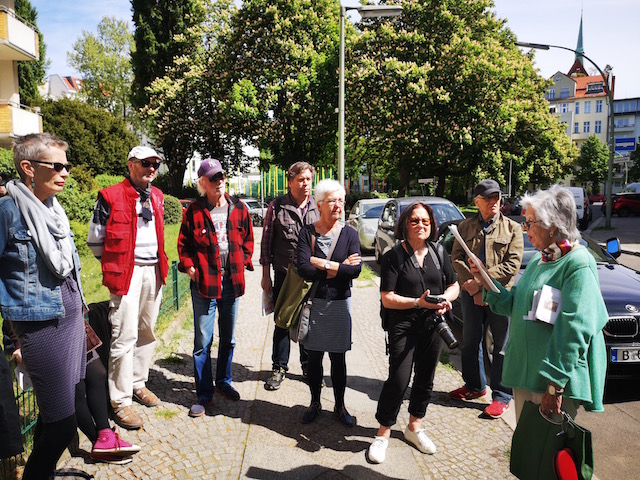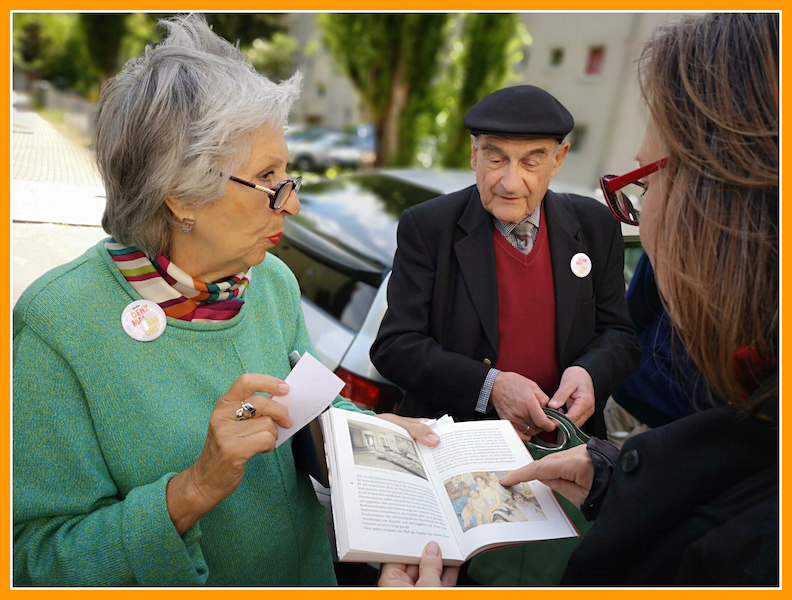Marie Rolshoven, a cultural scientist, lives in Berlin in Schöneberg neighbourhood, which was once home to Jewish artists and intellectuals such as Albert Einstein. Moved by the fact that, twenty three former Jewish residents of her whole building were deported during the Nazi era, she wanted to keep the history of her neighbours alive.
Inspired by the Amsterdam project Open Jewish Homes, Marie together with her mother Jani Pietsch (historian and artist) brought the idea from Amsterdam to Berlin, extending the concept of remembrance of Jewish history to every individual or family persecuted in Berlin at that time. They call the initiative ‘Denk mal am Ort’. It is a play on words: it can be translated as “think on the spot” or “memorial at a place”.
Citizens of Berlin, who want to take part in ‘Denk mal am Ort’ and keep Jewish history alive, open their homes for one weekend of the year. They explain about the lives and fate of former Jewish residents, who were forced from these very same homes by the Nazis. Citizens remember their Jewish neighbours through talks, readings, photographs and historical documents. It is important to learn about their stories to remember them.

But before all of that, Jani and Marie provide citizens with advice on how they can find out whether their house or apartment was the home of someone persecuted during the Nazi era, and if so, which Berlin directories to use to search for Jewish history in Berlin and their former neighbours. Certainly, older residents are often more familiar with the history of the house or neighbouring houses.

Schirmer, one of the neighbors in the Gervinusstrasse 20 A, has been researching the lives of former Jewish residents.
‘Denk mal am Ort’ is a great initiative which offers Berliners direct access to Jewish history and other victims of the Nazi regime, with the difference that this time it is told among fellow citizens, from neighbour to neighbour at their private residences, the original sites in Berlin where they lived, a former apartment, a courtyard, a garden, a cellar, a stairwell, in front of a residential building, a workplace, a university or where they hid from their persecutors.
Like in Marheinekeplatz in the Kreuzberg neighbourhood, where the well-known boxer Sinto Johann Trollmann, of Sinti heritage, and seven other victims were commemorated. Sinto was stripped of his German Championship boxing title in Berlin by the Nazis in 1933. His 80 years old daughter came unexpectedly to the site to remember him.

Jack M. Weil, the son of Ruth Reich, who was the sole survivor of her family, came from Amsterdam to Berlin to take part in DENK MAL AM ORT in the Gervinusstrasse 20 A.
“We want to encourage citizens to think on the spot and, in a way, we want to contribute to build a strong society. We bring people together, do the curatorial work and some research and organise the commemoration weekend itself”, explains Jani.
The initiative began in 2016. With the recent support of the Senats’ administration for Culture and Europe, Marie and Jani could afford this year to bring some former Jewish residents living abroad to the homes where their families used to live. Listening to the current German residents telling their stories can be very rewarding for everybody.
‘Denk mal am Ort’ is a living memorial to the holocaust, but beyond that, it is also a way of promoting tolerance toward minorities in the city such as Jewish history. A city’s true wealth is its people and the rich cultural diversity they represent. It is part of a city’s history.
Any citizen can contribute to this initiative – individuals, interest groups, house communities, associations – anyone who would like to remember a particular person or family in a creative way. “There are no limits to creativity when it comes to remembrance”, say Jani and Marie.
“Every home has a story to tell and it is good to shed more light on it once a year”, pointed out the Dutch activist Denise Citroen, who initiated Open Jewish Homes in Amsterdam.
Citizens not only need to talk openly about the history in their city; it is their responsibility to keep the history alive.




